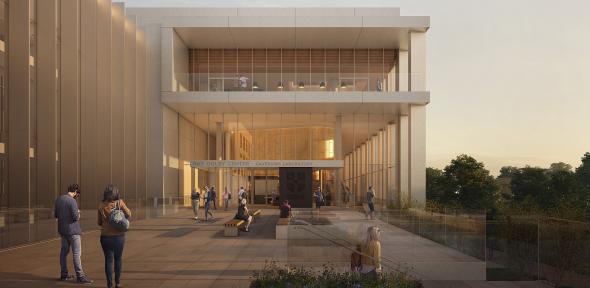Submitted by Biky Wan on Fri, 16/02/2018 - 09:14
The University of Cambridge has gained planning approval (subject to legal agreement) from the local authority for the Cavendish III project, to construct a new building, to be known as the Ray Dolby Centre, for the Department of Physics on the University’s West Cambridge site.
The new Cavendish III laboratory building - the third home for the Cavendish Laboratory since its foundation in Cambridge in 1874 - has been designed to provide excellent facilities for the staff and students of the University’s Department of Physics and to be a flagship building for the site which will support the ambition for West Cambridge to be a premier site for Physical Sciences and Technology in the country. As well as being the focus of physics research and teaching at Cambridge, Cavendish III will act as a university-based national facility for physics.
The Cavendish Laboratory has a global reputation and has been a powerhouse of physics research and teaching since it was established by William Cavendish in 1874. Its spin-off companies and alumni have been a major force in the local economy for many decades. Current research includes cosmology, discovery of new planetary systems, discovery of new particles at international projects such as CERN, and extends through to work on new materials currently addressing lighting, displays and battery technologies to aid future sustainability.
The new building provides adaptable facilities suited to future research and teaching. The design brings architectural distinction and gravitas, and marks a new era for the West Cambridge site. The plan includes a public wing which is more accessible than has been common in university buildings, along with a new area of public open space and a new cycleway along JJ Thomson Avenue.
Very detailed consideration has been given to the challenge of being able to maintain a secure environment for advanced research while continuing outreach work, through which each year the department welcomes thousands of children from local schools, and the wider public at open days and lectures.
The building has many specialised features for research, including a very stable basement, and a large cleanroom; all designed to a BREEAM Excellent environmental standard.
The building includes a diverse range of spaces including cleanrooms, laboratories, offices, reception, exhibition, lecture theatres, seminar rooms, learning resource centre, outreach, computer room, common room, meeting rooms, supervision rooms, teaching laboratories, workshops and stores. Collaboration between users has been designed into the spaces which are highly flexible and adaptable by architects Jestico + Whiles.
Professor Andy Parker, Head of the Department of Physics said: “The impact of the work of the Cavendish is well documented from the ground-breaking science which has taken place. The new facility will help the Department and University to continue the excellent research work that will benefit society around the world.”
The government is contributing £75 million towards the cost of the new building to support the national facility aspects of the project. The University has also received a generous gift of £85m from the Ray Dolby Foundation announced in December 2017. In recognition of this gift the new building will be named the Ray Dolby Centre.
Enabling construction works have commenced and the building will be completed in 2022.

